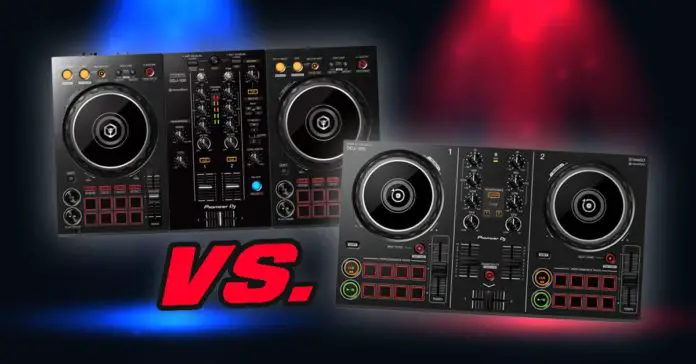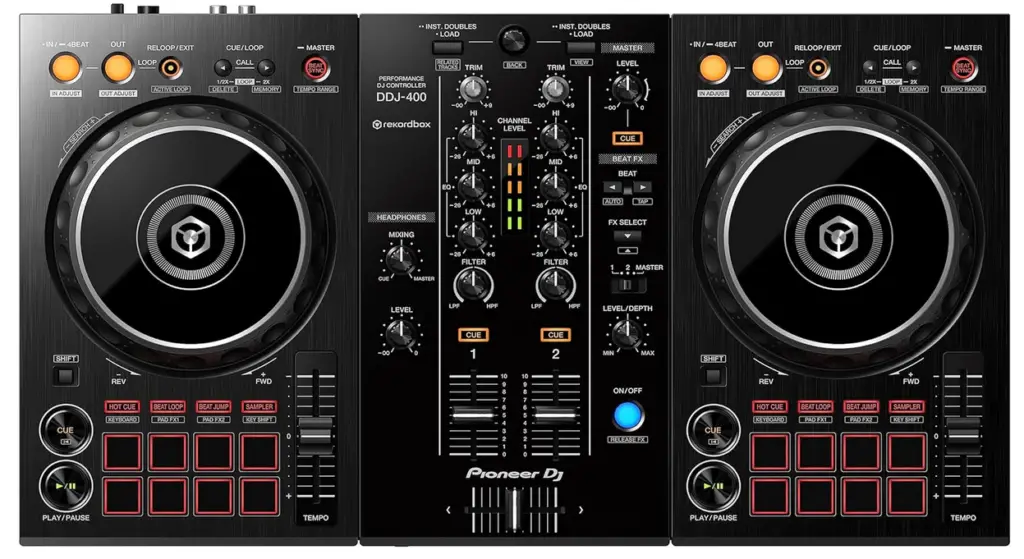DDJ-400 vs. DDJ-200 direct straight to-the-point gear comparison. Which one should you buy? The two controllers in question are with no doubt the most popular choices for beginner DJs. When choosing between DDJ-200 and the DDJ-400 there are a few important things that you need to keep in mind. The purpose of this article is to help you decide and make a good purchase that will satisfy all your DJ gear needs.
If you’re interested in other modern DJ controllers suitable both for beginners and more advanced performers check out our extensive article about DJ gear we recommend here: What Equipment Do You Need To DJ?
Let’s go over all of the most important points comparing the mentioned devices!
Click here to instantly skip straight to the pros and cons summary!
1. Built-in soundcard
2. The loop section controls
3. Track library controls
4. Performance pads
5. The FX section
6. Portability and mobile devices
7. Software integration
8. The microphone input
9. The conclusion
This web portal is supported by its readers, and is a part of the Amazon Services LLC Associates Program and the eBay Partner Network. When you buy using links on our site, we may earn an affiliate commission!
DDJ-200 does not have a built-in sound card.
What does this mean for you? With the DDJ-200 you will have to connect your speakers directly to your laptop/smartphone because this controller does not have its own audio connector outputs.
You will have to connect your laptop or a smartphone to the DDJ-200 via USB and then from there connect your speakers directly to the laptop’s/smartphone audio jack output. The DDJ-200 USB port is used simultaneously for powering the device, controlling the DJ software and sending the audio signal.
The DDJ-400 on the other hand features a sound card and an RCA output and you will be able to connect your speakers directly to the unit using appropriate cables.
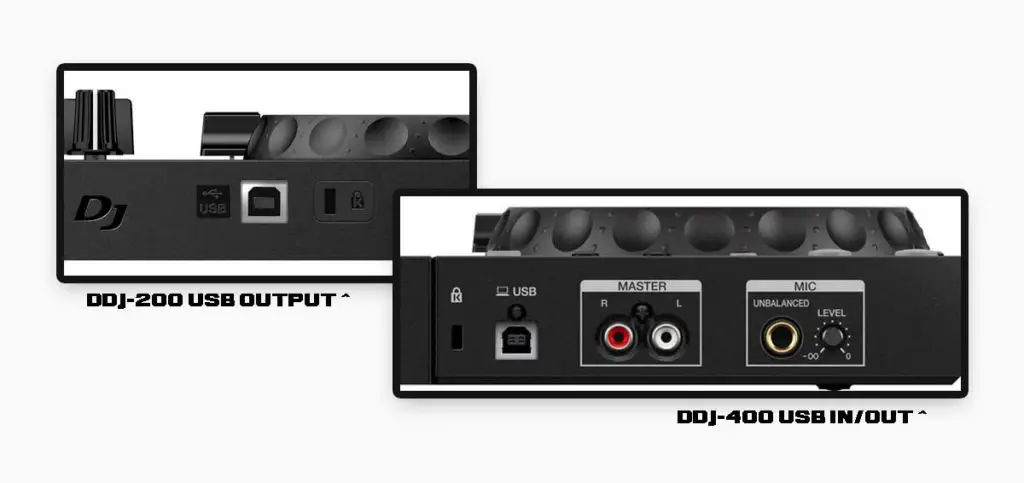
The DDJ-200 also doesn’t feature channel gain control knobs (trim knobs) so you won’t be able to tweak and fine tune the gain of each mixer channel on the device itself. The LED channel level indicators are also not present on the DDJ-200 while the DDJ-400 has small channel level indicator lights for each mixer channel.
The last difference here is that while you can adjust the headphones playback volume directly on the DDJ-400 by using a dedicated knob, you cannot do that on the DDJ-200 – the master gain, headphone gain and trim knobs aren’t present on the DDJ-200 and you have to adjust all these things in the software you’re using.
You won’t find physical loop buttons on the DDJ-200.
The whole loop section containing the loop start/end buttons and the reloop button is missing from the DDJ-200 and it’s present on the DDJ-400.
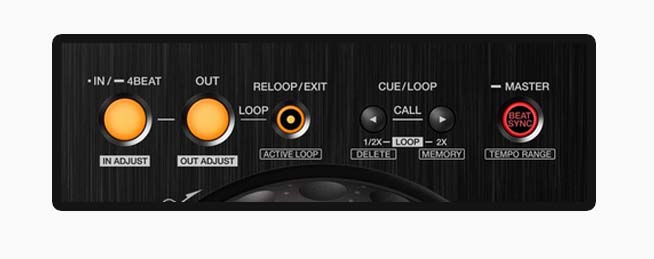
While on the DDJ-200 you won’t be able to control loops using physical buttons, the whole loop functionality is easily accessible from the DJ app of your choice.
For example in the WeDJ app you will be able to choose the loop settings in-app and then control the loops using the performance pads section.
DDJ-200 has no track selection controls.
This means that you can’t select a track from your library using the buttons on the DDJ-200. You will have to go through the track selection process on your PC or mobile device each time you want to load a new track.
The DDJ-400 features both the knob for choosing tracks and navigating through the library and load buttons for each mixer channel.
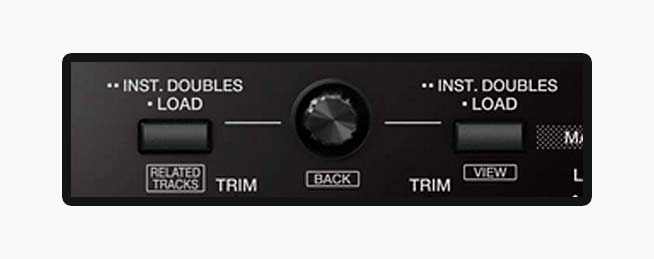
The performance pads.
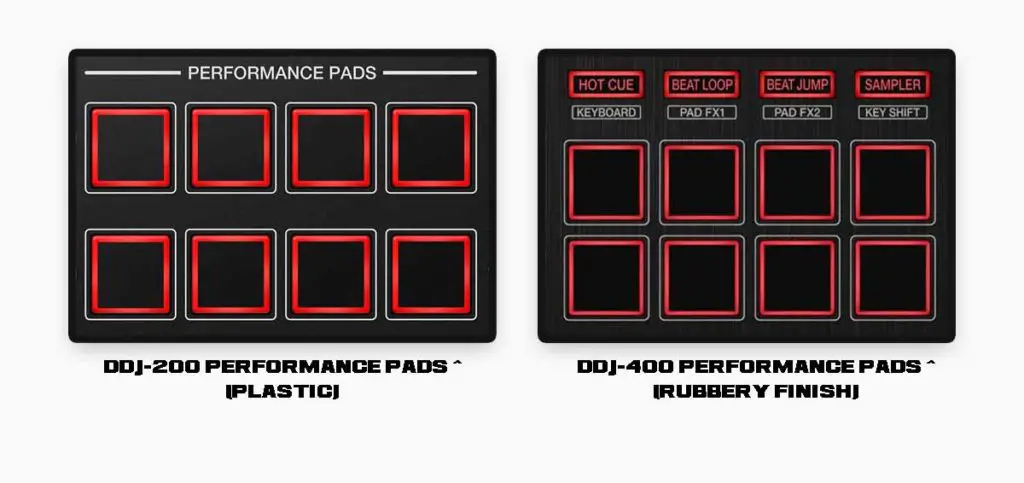
The DDJ-200 features 8 plastic performance pads without the pad mode buttons.
The DDJ-400 has 8 rubbery performance pads and pad mode selection buttons above them.
Both in DDJ-200 and the DDJ-400 the pads are clicky (although the DDJ-200’s seem to have a considerably louder click), not velocity-sensitive, and they feel nearly the same in terms of software control.
The DDJ-200 does not feature pad mode selection buttons so for changing the behavior of the pad section mid-performance you will have to use your mobile device’s screen.
There is no dedicated sound FX section on the DDJ-200.
The DDJ-400 has its own FX section alongside with pad mode selection buttons over the pad section.
The DDJ-200 makes up for it’s lack of dedicated sound FX section with two ways to control effects from the hardware level. One way is to go into your mixing app and assign sound color FX to the filter/sound color fx knobs below the equalizer on the mixer section (the knobs labeled CFX), the second way is to use the transition FX controlled with a button located over the crossfader.
The buttons that let you change the performance pad modes also aren’t present on the DDJ-200.
DDJ-200 is made with mobile devices in mind.
The DDJ-200 is much smaller and much more compact than the DDJ-400 as it is made with mobile devices in mind. It is meant to be used with smartphones and tablets and carried around in a bag. While targeting mobile devices the DDJ-200 can also be used with the Rekordbox software on your PC or your laptop.
The DDJ-200 lacks numerous important hardware controls – the designers expect the user to mess around with the mobile device a lot and thus they haven’t included library browsing controls, dedicated FX section, gain controls and so on. Those features are meant to be accessed only in-app which can be challenging at times especially with a small mobile device’s touch display.
There is also quite a large difference in weight where the DDJ-200 weighs around 4 pounds (1.8 kg) and the DDJ-400 around 7 pounds (3 kg). There is also a considerable difference in size.
What Equipment Do You Really Need To DJ? – Gear Recommendations
Both devices feature only 2 mixer channels.
Two mixer channels are enough for many people and most of the time are certainly enough for beginner DJs however if you want to start off by building a future proof and extensible setup you might want to consider getting a 4-channel DJ controller from the slightly higher price point such as the DDJ-1000 or the DDJ-SZ.
DJ Software integration.
The DDJ-400 comes with a Rekordbox software license while the DDJ-200 does not. If you want to use the DDJ-200 with Rekordbox you will have to have it connected to your PC when you use the software (the unit acts as a software activation dongle).
You can use both the DDJ-200 and the DDJ-400 with your laptop or your PC and with your mobile devices.
Microphone input.
The DDJ-400 features a jack microphone input albeit the only microphone level control is a small knob located on the back of the device. The microphone input is stacked on top of the general audio output of the device.
The DDJ-200 doesn’t feature a microphone input so you won’t be able to use your mic with the device unless you are using an external audio mixer.
The conclusion:
DDJ-200:
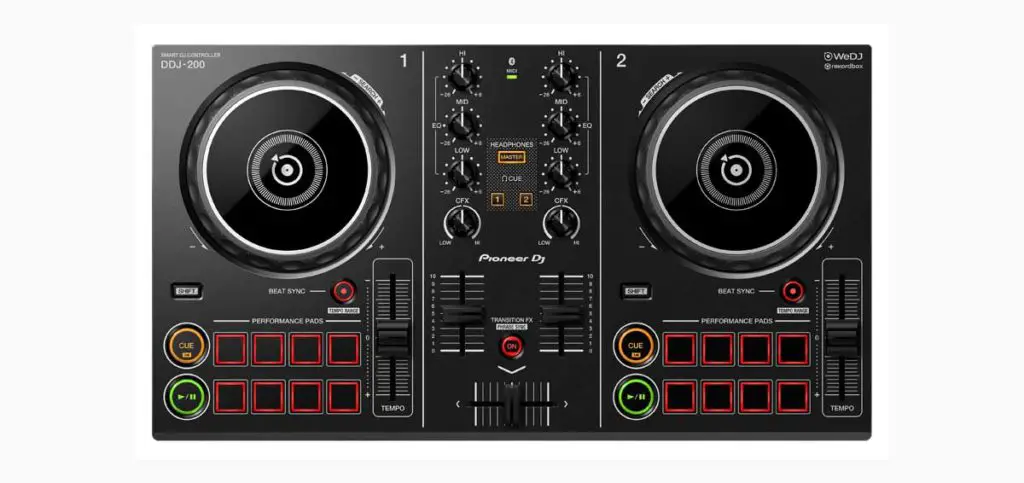
+ The portability factor (much smaller than the DDJ-400, fits in a small bag or a backpack).
+ Powered through USB – single cable setup great for portability.
+ Proper and sturdy build for a portable device.
+ Rekordbox Plug-and-play (acts like a software activation dongle).
– Lack of a proper dedicated sound FX section.
– No track selection section on the unit.
– The unit feels much cheaper in terms of design (not build quality).
– No master level controls, headphone level controls & no gain trim channel knobs.
– Many actions are meant to be performed in-app only and there are no shortcut buttons for them on the DDJ-200 (such as choosing different sound FX and performance pad modes).
DDJ-400:

+ Standalone Rekordbox software license included.
+ A whole dedicated sound FX section.
+ Proper track selection controls on the unit.
+ A microphone input.
+ Proper RCA audio outputs.
+ Headphone level controls.
– Small but not quite portable (and noticeably heavier than the DDJ-200)
– Still features only a half-sized tempo fader.
– Poor microphone input controls.
Which one should you choose?
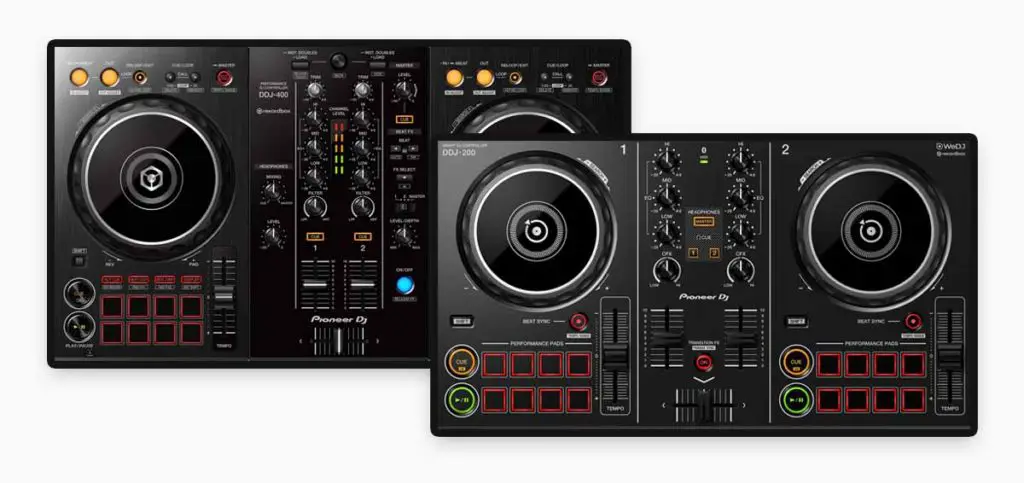
All things considered the Pioneer DDJ-200 is a very basic budget device that is meant either for yet unsure beginners or strictly for mobile use. It lacks many key features that the Pioneer DDJ-400 offers for a similar price. It’s important to add that many features that are present in the DDJ-400 are also accessible while mixing with the DDJ-200 but you have to use the mobile app interface to get to them and this is generally not an efficient solution.
Overall whether it’s your first DJ controller, you search for a sturdy DJ controller for your curious kid or you want to find some portable gear for mobile usage the Pioneer DDJ-200 will be a great choice.
If you want to take a little but meaningful step further, save yourself some money on a future upgrade and start off learning how to DJ with all the core vital functions present on the hardware level you are far better off choosing the Pioneer DDJ-400.
| Pioneer DDJ-200 on Ebay: |
| Pioneer DDJ-400 on Ebay: |
In conclusion, the Pioneer DDJ-400 is a better choice hardware wise and overall a better choice for a beginner. It offers much more for a little more money, has a standalone Rekordbox software license bundled with it and is more comfortable to use. All that while still keeping a somewhat portable form factor.
Is it worth getting a used DDJ-400?
If you are tight on the budget you might be considering compensating for the DDJ-400 price by buying it used. Keep in mind that there are many risks that come along with getting used DJ equipment.
Also when buying a used DDJ-400 make sure that the Rekordbox DJ license comes with it or if the previous owner is able to transfer the license to you.
Otherwise if you’d like to check out other affordable DJ controllers with more features recommended by us click here: What Equipment Do You Really Need To DJ? – Gear Recommendations
Check out also: Denon DJ SC Live 4 vs. Prime 4 (Direct Comparison!)
Article image partial: Designed by starline / Freepik

